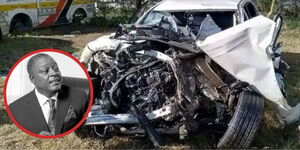Replacing old side mirrors with cameras is becoming one of the latest trends in modern vehicle designs.
The concept is taking root in the international scene with some modern cars such as Audi e-Tron, Honda E drives, and Cadillac CT6 among others either offering mirror cameras as an option or standard.
At first glance, the concept sounds alluring to motorists as they embrace the new latest technology trends. Kenyans.co.ke, however, takes a look at the pros and cons of this relatively new concept in the market.
The common argument for the advantage of cameras replacing side mirrors is the elimination of blind spots.
According to international publication, Arenaev, the cameras have wide-angle lenses which provide a better view of the road.
"Blindspots are perhaps the biggest hazard when it comes to side mirrors, so we welcome any solution that helps with that," read part of the publication.
In 2020, a similar concept was welcomed after Kia's blind spot system scooped the Autoblog 2020 Technology of the year award. The camera system was fed into the dashboard hence allowing the motorist to see a person a few centimetres ahead.
"It uses a system of cameras to display a live camera feed of either the left or right blind spot in the central digital portion of the gauge cluster when the turn signal is activated," read part of the autoblog publication.
Further, cameras are praised for aerodynamics and less wind noise as compared to side mirrors.
Aerodynamics, in this situation, refers to the reduction of factors that cause a vehicle's instability at high speeds.
Cameras are more compact than regular mirrors hence offering efficiency and increase in the vehicle's range.
According to an international manufacturer, Honda, driving with mirror cameras provides a 3.8 percent improvement in efficiency and, in turn, range.
The mirror cameras also provide more detail in dark areas, tunnels, and parking at night as well as in bad weather. The cameras offer improved nighttime visibility with glare resistance.
"This is because their exposure, ISO levels, and white balance can be adjusted unlike with conventional side mirrors which are exposed to the elements and where we can only rely on our eyes," read part of the arenaev article.
On the other hand, mirror cameras have distinct cons; whereby the feature is only found inbuilt into specific modern designs and the price tag for the mirror cameras is relatively high depending on the type of camera lens.
Further, car experts opine that mirror cameras are expensive to maintain and replace.
Despite providing exquisite clear-cut footage on sunny days due to the lens flare, the camera's durability is called into question, especially for areas with poor lighting conditions over time.
Display placement on the dashboard can become a distraction for the driver who will develop the habit of looking at the display to look at the camera angles.
In conclusion, the future of modern and electric vehicles is heavily influenced by tech appeal features that provide comfort and luxury in a bid to woo the audience. The decision is ultimately left to the motorist.
Would you opt to replace your side mirrors for cameras?












